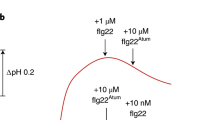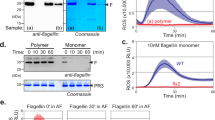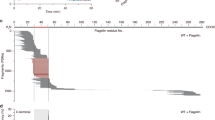Abstract
Plants and animals recognize microbial invaders by detecting pathogen-associated molecular patterns (PAMPs)1,2,3,4,5 such as flagellin6,7,8,9,10. However, the importance of flagellin perception for disease resistance has, until now, not been demonstrated7,8,9,10,11. Here we show that treatment of plants with flg22, a peptide representing the elicitor-active epitope of flagellin6, induces the expression of numerous defence-related genes and triggers resistance to pathogenic bacteria in wild-type plants, but not in plants carrying mutations in the flagellin receptor gene FLS2. This induced resistance seems to be independent of salicylic acid, jasmonic acid and ethylene signalling. Wild-type and fls2 mutants both display enhanced resistance when treated with crude bacterial extracts, even devoid of elicitor-active flagellin, indicating the existence of functional perception systems for PAMPs other than flagellin. Although fls2 mutant plants are as susceptible as the wild type when bacteria are infiltrated into leaves, they are more susceptible to the pathogen Pseudomonas syringae pv. tomato DC3000 when it is sprayed on the leaf surface. Thus, flagellin perception restricts bacterial invasion, probably at an early step, and contributes to the plant's disease resistance.
This is a preview of subscription content, access via your institution
Access options
Subscribe to this journal
Receive 51 print issues and online access
$199.00 per year
only $3.90 per issue
Buy this article
- Purchase on SpringerLink
- Instant access to full article PDF
Prices may be subject to local taxes which are calculated during checkout



Similar content being viewed by others
References
Medzhitov, R. & Janeway, C. A. Jr Decoding the patterns of self and nonself by the innate immune system. Science 296, 298–300 (2002)
Takeda, K., Kaisho, T. & Akira, S. Toll-like receptors. Annu. Rev. Immunol. 21, 335–376 (2003)
Tzou, P., De Gregorio, E. & Lemaitre, B. How Drosophila combats microbial infection: a model to study innate immunity and host–pathogen interactions. Curr. Opin. Microbiol. 5, 102–110 (2002)
Kurz, C. L. & Ewbank, J. J. Caenorhabditis elegans: an emerging genetic model for the study of innate immunity. Nature Rev. Genet. 4, 380–390 (2003)
Aballay, A., Drenkard, E., Hilbun, L. R. & Ausubel, F. M. Caenorhabditis elegans innate immune response triggered by Salmonella enterica requires intact LPS and is mediated by a MAPK signaling pathway. Curr. Biol. 13, 47–52 (2003)
Felix, G., Duran, J. D., Volko, S. & Boller, T. Plants have a sensitive perception system for the most conserved domain of bacterial flagellin. Plant J. 18, 265–276 (1999)
Asai, T. et al. MAP kinase signalling cascade in Arabidopsis innate immunity. Nature 415, 977–983 (2002)
Gómez-Gómez, L. & Boller, T. FLS2: an LRR receptor-like kinase involved in the perception of the bacterial elicitor flagellin in Arabidopsis. Mol. Cell 5, 1003–1011 (2000)
Smith, K. D. et al. Toll-like receptor 5 recognizes a conserved site on flagellin required for protofilament formation and bacterial motility. Nature Immunol. 4, 1247–1253 (2003)
Hayashi, F. et al. The innate immune response to bacterial flagellin is mediated by Toll-like receptor 5. Nature 410, 1099–1103 (2001)
Nürnberger, T. & Brunner, F. Innate immunity in plants and animals: emerging parallels between the recognition of general elicitors and pathogen-associated molecular patterns. Curr. Opin. Plant Biol. 5, 318–324 (2002)
Dangl, J. L. & Jones, J. D. Plant pathogens and integrated defence responses to infection. Nature 411, 826–833 (2001)
Staskawicz, B. J., Mudgett, M. B., Dangl, J. L. & Galan, J. E. Common and contrasting themes of plant and animal diseases. Science 292, 2285–2289 (2001)
Boller, T. Chemoperception of microbial signals in plant cells. Annu. Rev. Plant Physiol. Plant Mol. Biol. 46, 189–214 (1995)
Felix, G., Regenass, M. & Boller, T. Specific perception of subnanomolar concentrations of chitin fragments by tomato cells. Induction of extracellular alkalinization, changes in protein phosphorylation, and establishment of a refractory state. Plant J. 4, 307–316 (1993)
Granado, J., Felix, G. & Boller, T. Perception of fungal sterols in plants: subnanomolar concentrations of ergosterol elicit extracellular alkalinization in tomato cells. Plant Physiol. 107, 485–490 (1995)
Dow, M., Newman, M. A. & von Roepenack, E. The induction and modulation of plant defense responses by bacterial lipopolysaccharides. Annu. Rev. Phytopathol. 38, 241–261 (2000)
Navarro, L. et al. The transcriptional innate immune response to flg22: interplay and overlap with Avr gene-dependent defence responses and bacterial pathogenesis. Plant Physiol. (in the press)
De Gregorio, E., Spellman, P. T., Rubin, G. M. & Lemaitre, B. Genome-wide analysis of the Drosophila immune response by using oligonucleotide microarrays. Proc. Natl Acad. Sci. USA 98, 12590–12595 (2001)
Irving, P. et al. A genome-wide analysis of immune responses in Drosophila. Proc. Natl Acad. Sci. USA 98, 15119–15124 (2001)
Eulgem, T., Rushton, P. J., Robatzek, S. & Somssich, I. E. The WRKY superfamily of plant transcription factors. Trends Plant Sci. 5, 199–206 (2000)
Bauer, Z., Gómez-Gómez, L., Boller, T. & Felix, G. Sensitivity of different ecotypes and mutants of Arabidopsis thaliana toward the bacterial elicitor flagellin correlates with the presence of receptor-binding sites. J. Biol. Chem. 276, 45669–45676 (2001)
Hammond-Kosack, K. E. & Parker, J. E. Deciphering plant-pathogen communication: fresh perspectives for molecular resistance breeding. Curr. Opin. Biotechnol. 14, 177–193 (2003)
Gómez-Gómez, L., Felix, G. & Boller, T. A single locus determines sensitivity to bacterial flagellin in Arabidopsis thaliana. Plant J. 18, 277–284 (1999)
Peck, S. C. et al. Directed proteomics identifies a plant-specific protein rapidly phosphorylated in response to bacterial and fungal elicitors. Plant Cell 13, 1467–1475 (2001)
Beattie, G. A. & Lindow, S. E. The secret life of foliar bacterial pathogens on leaves. Annu. Rev. Phytopathol. 33, 145–172 (1995)
Feng, C. G. et al. Mice lacking myeloid differentiation factor 88 display profound defects in host resistance and immune responses to Mycobacterium avium infection not exhibited by Toll-like receptor 2 (TLR2)- and TLR4-deficient animals. J. Immunol. 171, 4758–4764 (2003)
Hawn, T. R. et al. A common dominant TLR5 stop codon polymorphism abolishes flagellin signaling and is associated with susceptibility to Legionnaires' disease. J. Exp. Med. 198, 1563–1572 (2003)
Katagiri, F., Thilmony, R. & He, S. Y. in The Arabidopsis Book (eds Somerville, C. R. & Meyerowitz, E. M.) doi/10.1199/tab.0039, http://www.aspb.org/publications/arabidopsis (American Society of Plant Biologists, Rockville, Maryland, 30 September 2002)
Robatzek, S. & Somssich, I. E. Targets of AtWRKY6 regulation during plant senescence and pathogen defense. Genes Dev. 16, 1139–1149 (2002)
Acknowledgements
We thank H. Angliker for help with the microarray procedure; R. Ulm and D. Chinchilla for critically reading the manuscript; C. Molteni and B. Thürig for technical help; the Nottingham Arabidopsis Stock Centre for etr1-3, ein2-1, jar1-1, pad2-1 and pad4-1 seeds; the Torrey Mesa Research Institute for the SAIL_691-C4 line; J. Parker for eds1-2, sgt1b-3 and rar1-13 seeds; W. Achouak for the Pseudomonas brassicacearum strain; S. Y. He for Pseudomonas syringae pv. tomato DC3000 HrpS- mutant strain; and N. Kraus and H. Sierotzky for the plant growing facilities. This work was supported by the Novartis Research Foundation, by the Gatsby Charitable Foundation and by a grant from the Swiss National Foundation.
Author information
Authors and Affiliations
Corresponding author
Ethics declarations
Competing interests
The authors declare that they have no competing financial interests.
Supplementary information
Supplementary Methods
Description of the microarray experiment in MIAME compliant format. (DOC 23 kb)
Supplementary Figure 1
Genome-wide analysis of flg22-dependent gene expression in Ler-0 and fls2-17 seedlings. (PDF 85 kb)
Supplementary Figure 2
A null fls2 mutation in the ecotype Col-0 leads to enhanced disease susceptibility. Wild-type Col-0 and fls2 null mutant plants were sprayed with 5x108 cfu/ml Pst DC3000, or water. Symptoms and number of bacteria were scored 4 dpi. (PPT 184 kb)
Supplementary Figure 3
Ws-0 plants transformed with FLS2p::FLS2-3xmyc regain flg22 responsiveness. The complemented line expressed the FLS2-3xmyc fusion protein and regained the capacity to undergo flg22-induced oxidative burst and seedling growth inhibition. (PPT 95 kb)
Supplementary Table 1
Flagellin-regulated genes. (XLS 529 kb)
Supplementary Table 2
Resistance and resistance-associated genes induced upon flg22 treatment. (XLS 29 kb)
Supplementary Table 3
Receptor-like kinases induced upon flg22 treatment. (XLS 41 kb)
Supplementary Table 4
Frequency of occurrence of conserved motifs for different types of transcription factors in the flg22-induced RLK promoters. (PDF 84 kb)
Rights and permissions
About this article
Cite this article
Zipfel, C., Robatzek, S., Navarro, L. et al. Bacterial disease resistance in Arabidopsis through flagellin perception. Nature 428, 764–767 (2004). https://doi.org/10.1038/nature02485
Received:
Accepted:
Issue Date:
DOI: https://doi.org/10.1038/nature02485
This article is cited by
-
Expression of the Arabidopsis redox-related LEA protein, SAG21 is regulated by ERF, NAC and WRKY transcription factors
Scientific Reports (2024)
-
Commensal lifestyle regulated by a negative feedback loop between Arabidopsis ROS and the bacterial T2SS
Nature Communications (2024)
-
Plant U-box E3 ligases PUB20 and PUB21 negatively regulate pattern-triggered immunity in Arabidopsis
Plant Molecular Biology (2024)
-
DDM1-mediated gene body DNA methylation is associated with inducible activation of defense-related genes in Arabidopsis
Genome Biology (2023)
-
Defense against phytopathogens relies on efficient antimicrobial protein secretion mediated by the microtubule-binding protein TGNap1
Nature Communications (2023)



